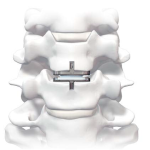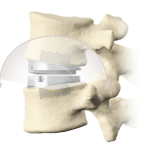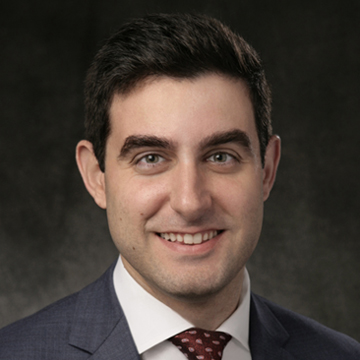Total Disc Replacement
Degenerative Disc Disease, or “DDD,” isn’t a disease at all.
Your spinal discs act as cushions to absorb shock between the vertebrae during movement. As a result of aging or injury, sometimes the spinal disc loses its cushioning effect which may result in a loss of disc height. This loss of disc height reduces the distance between the vertibral bodies and may cause irritation or pinching of the nerves. The spinal disc may also bulge or herniate, where the disc material contained within the intervertebral disc is pushed into the spinal canal. This may cause inflammation and pressure on the local nerve.
The loss of disc height and/or bulge of the disc may result in the following symptoms.
- Pain or discomfort in the nect or back
- Tingling or loss of feeling in arms or legs
- Shooting pain or discomfort in one or both legs
- Discomfort that worsens upon standing or activity
Treatment options – Disc Replacement
What are the options for treating spinal conditions?
Your doctor will likely first use treatment options such as physical therapy, heat, and anti-inflammatory medications. For the vast majority of patients, pain will subside over time using these types of conversative methods.
Additional forms of treatment may become necessary – such as injections and nerve root blocks. If found effective, these treatments can be performed several times by a pain management physician or physiatrist (physical medicine and rehabilitation physician). These injections work by decreasing inflammation and, ultimately, the pain from irritated nerves.
If conservative forms of treatment fail to relieve your symptoms, then surgery may be presented as an option.
There are many surgical solutions for treating DDD depending upon a patient’s diagnosis, physical condition, surgeon’s training and many other factors. Your surgeon will discuss the options that are available for your situation. One of those options may include an anterior fusion surgical procedure called Total Disc Replacement (TDR) or Anterior Cervical Discetomy Fusion (ACDF) for neck (cervical) conditions, Anterior Lumbar Interbvody Fusion (ALIF or Lateral Lumbar Intervody Fusion (LLIF) for low back (lumbar) conditions.
What is disc replacement?
Total disc replacement (TDR) may be a solution for some patients with degenerative disc disease as an alternative to spinal fusion. Early research into artifical disc replacement began in the 1960s because of the complications sometimes caused by spinal fusion. Insurance coverage changes over the last few years have enabled more and more patients to receive this alternative procedures to become the fastest grwoing procedure in spine, representing nearly 10% of fusions.
 During disc replacement surgery, the doctor removes the damaged disc and replaces it with an artificial disc. The goals of total disc replacement surgery are to maintain spinal balance and motion, reduce adjacent level degeneration, and allow patients to get back to activities of daily living.
During disc replacement surgery, the doctor removes the damaged disc and replaces it with an artificial disc. The goals of total disc replacement surgery are to maintain spinal balance and motion, reduce adjacent level degeneration, and allow patients to get back to activities of daily living.
Disc replacement surgery is performed by a spine surgeon in either the cervical or neck region of the spine or in the lumbar or lower back region. The surgical approach for the neck and lower back is through the front of the body, referred to as an anterior approach. Disc replacement surgery starts with surgical access to the spine, followed by removal of the patient’s diseased disc. Once the diseased disc has been removed, the total disc replacement is implanted.
 A disc replacement device consists of two cobalt chrome endplates containing and articulating over a domed polyethylene core to restore stable motion to the spine. The clinical trials on disc replacement proved the effectiveness of this option – specifically a reduction in pain and improvement in a patient’s quality of life. Disc replacement is not appropriate for all patients and your surgeon will help you understand if this procedure is right for you.
A disc replacement device consists of two cobalt chrome endplates containing and articulating over a domed polyethylene core to restore stable motion to the spine. The clinical trials on disc replacement proved the effectiveness of this option – specifically a reduction in pain and improvement in a patient’s quality of life. Disc replacement is not appropriate for all patients and your surgeon will help you understand if this procedure is right for you.
Dr. Goldstein uses Prodisc articial discs for total disc replacement in both the cervical and lumbar spine.
Prodisc C Design
Prodisc C has a long clinical history (15+ years) and has been widely used throughout the world for cervical spine disc replacement. The Prodisc line of total disc replacement (TDR) is the most widely studied TDR, with over 400 peer-reviewed published success studies, reporting on over 13,000 patients. The first implantation of a Prodisc C took place in 2001.
Benefits:
- Maintaining spinal balance and motion. Degenerative disc disease can be a segmental destabilizing process. In addition, conducting the surgical procedure to perform a discectomy is inherently destabilizing. In order to provide stabilizing constraints, the Prodisc mechanism of action enables movement with a fixed center of motion yet still allowing a normal range of motion in flexion /extension, lateral bending, and axial rotation.
- Decelerate adjacent level re-operations. The ‘gold standard’ for treating degenerative disc disease is to conduct a fusion and fuse the joint. However, immobilizing a segment of the spine has been shown to increase the rate of adjacent level degeneration. Enabling motion through the Prodisc artifical disc however, adjacent level degeneration may be decelerated. A clinical study showed that at five years follow-up, patients had 3.5 times more development of adjacent level disease with fusion that with Prodisc C.
Prodisc L Design
Prodisc L has a 25+ year clinical history and has also been widely used through the world, with the first implantation of a Prodisc L for lumbar spine disc replacement taking place in 1990.
Like Prodisc C, ProDisc L:
- Maintains spinal balance and motion
- Decelerates adjacent level reoperations
- Accelerates the resumption of activities of daily living
What is DDD?
DDD stands for Degenerative Disc Disease and is one of the most common causes of neck and back pain. It refers to the brekdown of one of more discs (shock absorbing soft tissue structure between each vertebra) in the spine and is linked to neck and back pain with or without shooting pain, numbness and weakness in the arms or legs.
Is Degenerative Disc Disease Really a Disease?
DDD isn’t really a disease but a way to refer to the natural breakdown of spinal discs over time. DDD can lead to a loss of disc heigh that may cause pain, numbness or weakness in the back, arms or legs.
Can an Injury Cause DDD?
Yes. Sometimes an injury causing severe damage to spinal discs can disrupt them causing a disc to bulge, stick out or lose height, regardless of the aging process.
What are the Symptoms of DDD?
The symptoms of DDD may include back pain with or without arm or leg pain as well as arm or leg weakness, tingling or numbness. DDD pain often gets worse with movement like bending or twisting. Only a licensed spine specialist can accurately diagnosis a spinal condition like DDD.
How is DDD Diagnosed?
A DDD diagnosis starts with a standard questionnaire that details the patient’s symptoms and where they occur. The, a spine specialist performs a routine physical exam of the back, arms, hands, legs and feet while testing for strength, flexibility, range of motion, reflexes and pain.
The spine specialist may also order some tests, like a bone scan, disogram/discography or myleogram to assist in the diagnosis.
- A Bone Scan can be used to identify health concerns like osteoarthritis, fractures or infections. It is a non-invasive test where a small amount of radioactive medicine is injected into the blood and then absorbed by the bone. More of the medicine will be absorbed in bony areas that are abnormal or problematic. A scan of the spine is then taken and the areas where the medicine has been absorbed will be seen as hot spots and light up on the scan. These hot spots identify where the problem maybe in the spine.
- A Discogram or Discography is a test to determine if a specific spinal disc is causing pain or other discomfort. The test is non-invasive, with a dye injected into a suspected problem disc and an x-ray is taken. If the dye stays within the disc space then the disc is normal. If the dye leaks out then the disc has a problem, like a herniation or bulge. The test pinpoints the problem disc for the spine specialist to treat.
- Myelogram is a non-invasive test to determine if the problem is with the spineal cord or in the spinal canal (the bony opening surrounding the spinal cord). A medical dye is injected into the spinal canal and then an x-ray or CT scan is taken. The scan or image will show a detailed picture of the spine and surrounding bones and nerves. By reviewing the scan, the spine specialists can identify any abnormalities or problem areas.
In addition to these tests, the specialist may also order x-rays, computerized tomography (CT) scan or magnetic resonance imaging (MRI) to get a visual understanding of the spine and associated abnormalities or areas of concern. A CT or MRI shows the soft tissue of the spine, not just the bones like an x-ray, so the spine specialist can identify the locations and nature of the problem causing discomfort.
I Have Been Diagnosed With DDD, do I Need Surgery?
There are many nonsurgical treatments for DDD. Some of the nonsurgical treatment options that may be discussed with a doctor are: pain management, bracing and physical therapy, among others. Only once these non-surgical treatments have been utilized witll your physician or surgeon likely discuss surgical options.
When Should Spine Surgery Be Considered?
There are many nonsurgical treatment options that should be considered prior to making the decision about spine surgery. Spine surgery should be the last option. The more conservative, nonsurgical treatments for back pain and associated arm and leg pain include physical therapy, bracing, pain management and may other options. Only once these conservative treatments have been utilized will your physician or surgeon likely discuss surgical options.
What type of Surgical Solutions are Available to Treat DDD?
There are many surgical solutions for treating DDD depending upon a patient’s diagnosis, physical condition, surgeon’s training and many other factors. Your surgeon will discuss the options that are available for your situation. One of those options may include an anterior fusion surgical procedure called Total Disc Replacement (TDR) or Anterior Cervical Discetomy Fusion (ACDF) for neck (cervical) conditions, Anterior Lumbar Interbvody Fusion (ALIF or Lateral Lumbar Intervody Fusion (LLIF) for low back (lumbar) conditions.
What is Disc Replacement Surgery?
A disc replacement surgery is performed to resolve pain or discomfort in the back, neck, or extremities due to a diseased or degenerated spinal disc or discs. The procedure should be performed by a spine surgeon and can be done in a hospital or surgery center.
The goal of disc replacement surgery is to remove a diseased, often dehydrated disc and replace it with a device that enables motion within the diseased segment of the spine. By removing the diseased disc and implanting a disc replacement, your surgeon can remove the source of pain or discomfort generated from a nerve that is being pinched or compressed.
To perform a disc replacement, the surgeon will approach the spine from the front (anterior). Once at the location of the degenerated disc, the surgeon will remove the problem disc along with any other areas of concern and replace it with a spinal device to restore the height of the disc space, which usually frees a pinched or compressed nerve. The implanted spinal device is designed to support the body’s natural healing process to achieve solid fixation between the device and the bone.
Spinal fusion surgery duration varies depending on a number of factors: patient’s health condition, number of discs being treated, surgical approach, etc. After the procedure, the patient can expect to be in the hospital for a few days and recovery can take several weeks. The spine surgeon reviews the surgery specifics and recovery expectations with the patient prior to the surgery.
Is This an Inpatient or Outpatient Procedure?
In many cases, spine surgery may be performed as an outpatient procedure. This depends on the patient’s diagnosis, the surgical procedure, physical condition, surgeon’s training and many other factors. Your surgeon will discuss the options that are available for your situation.
How Long Does it Take to Perform a Total Disc Replacement Procedure?
The time to complete a ttal disc replacement procedure depends on a variety of factors including the number of discs that require treatment, whether or not this is a reoperation and the severity of the condition. The surgeon should give you a general idea about surgical time.
When Can I Go Back to Work After Surgery?
The decision to go back to work should be discussed with your surgeon and decided on an individual basis. It will be based upon the type of surgical procedure performed, the results of the surgery, the type of work performed, etc. Typically, a patient will return to work within one to six weeks after spine surgery, although full recovery may take up to eight weeks. Your surgeon should provide a general idea about when you can expect to return to work.
What are the Prodisc Products Made of?
Prodisc C and Prodisc L devices are made of Cobal Chromium and Titanium alloy, as well as ultra-high molecular weight polyethylene, which is a medical grade plastic. All devices are designed to restore spinal alignment and height and enable motion.
How Safe are Prodisc Devices?
All Prodisc devices have undergone extensive clinical trials in the US in conjunction with the U.S. Food and Drug Administration (FDA). Long-term studies have been published on Prodisc C and Prodisc L, and over 14,000 patient experiences have been published on in over 420 peer-reviewed studies.
Total Disc Replacement as a Fusion Alternative
While Fusion is a proven and effective treatment for alleviating spine-related pain, Total Disc Replacement is an exciting potential alternative for some patients.
Why Go From the Front to Get to the Back?
Dr. Richard Guyer, Dr. Jessica Shellock, and Dr. Sandra Moore explain the benefits of anterior spinal surgery (surgery from the front) versus posterior spinal surgery (surgery from the back).
Brian Gay, 4-time PGA Tour winner


